Picture shows, to me they were picture shows and not until I went to college did I start to go to the movies, and that is when I became fascinated by motion pictures and the picture business. My interest was not exotic, mostly American films from the late 1920s through the early 1960s. I also developed an interest in the theaters themselves, those magic places where we sat in the dark watching shadows on the walls that carried us to times and places we could only imagine on our own.
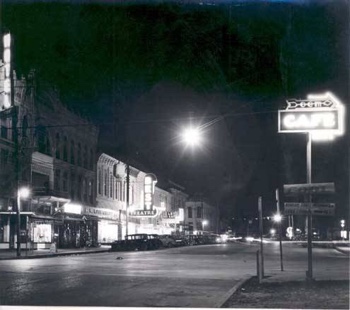
I have very fuzzy memory of going to a movie with my mother on a trip to San Antonio, I remember a train and somebody singing “Joshua Fit Battle of Jericho.” I would have been only three or four, so the idea may cut from whole cloth. My first real memories of the movies and the theaters literally are of the Best. The Best Theater was on the south side of the square in Bonham. It was open Friday and Saturday and catered to the kids and the country folks by showing an exclusive bill of program Westerns and serials.
Hunt’s Department Store was next door to the Best, and between the two was a stairway leading to my father’s law office over Hunt’s. When I was in the first and second grades I would leave Bailey Inglish School on Friday afternoons and walk, or be dropped off by my mother, downtown in front of the theater. I would run up the stairs, get a quarter from my father and go to the picture show.
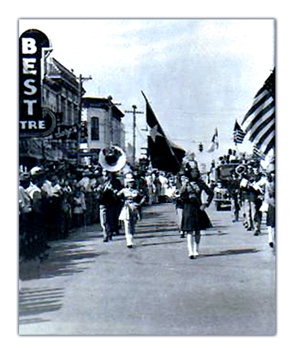
Admission was nine cents and a box of popcorn was a nickel. I would run down the aisle, grab a seat on the left side and enjoy the show. Why I always picked the left side of the theater I cannot fathom, but even today I do not like to sit to the right of the aisle.
Coming in halfway through a Rocky Lane or Wild Bill Elliot saga was not a problem. Even at seven or eight you could figure out the plot soon enough. The bad guy was usually Roy Barcroft or I. Sanford Jolly and the bad guy’s henchmen were the equally well recognized Bud Osborne or Keene Duncan. I would watch the show until five o’clock, and then I would go back up to the office and go home with my dad.

Bonham had two other theaters. The big house was the American, offering three bills a week, and the Elite on the west side of the square. The top films played at the American on Sunday, Monday and Tuesday. Wednesday and Thursday were for the more adult fare, grown up would be a better word—the crime dramas and romance films that held little interest for kids—and Friday and Saturday was cowboy or adventure time.
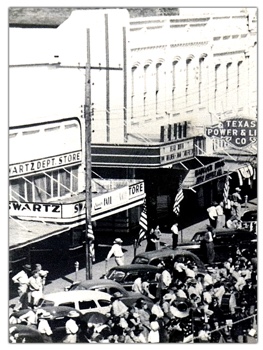
The Elite was a small house with no concession stand and a spiral staircase leading from the tiny lobby up to the projection booth. I wanted to climb up those stairs more than anything. The thought seemed so exciting. The Elite showed grown up films most of the time. When Major Cole, Bonham’s movie mogul, built the Bonham Drive-in it was open only in the warm weather months and when it closed for winter, the Elite filled the void.
All the performances came with trailers of coming attractions, a newsreel, a cartoon and sometimes a two-reel short. The first words my brothers learned to read were “Coming Attractions,” and they would shout it out with gusto when the big silver, glittering letters flashed on to the screen with a fanfare of trumpets.
Occasionally we would go to the picture show in other towns. In many cases, memories of these trips are very specific and connected to one movie. I remember seeing the Oscar-winning circus film The Greatest Show on Earth, in Leonard at the theater of the same name. Leonard was also the venue for Rock, Rock, Rock and Rock Around the Clock, both rock and roll movies with Alan Freed and names like Frankie Lymon and the Teenagers, Chuck Berry, Laverne Baker and Bill Haley and the Comets.
One Friday night when my mother was hosting the ladies bridge club, my father, my brothers and I traveled to Whitewright and saw a Western called New Mexico with Lew Ayres as a cavalry officer. I was particularly fond of cavalry pictures and still watch the great John Ford, John Wayne cavalry trilogy of Fort Apache, She Wore a Yellow Ribbon, and Rio Grande a couple of times a year.
Save for the Campus Drive-in out on the Bonham highway, which was a favorite of mine when I was in high school (Drive-ins are another story.), the only movie I can remember seeing in Sherman was The Crimson Pirate with Burt Lancaster. It was at the Plaza, and it was a family affair, probably to top off a birthday dinner for my mom or dad at McCraw’s Restaurant.

By the time I got to college the cool term for movies was flics and there were two flics on the Drag (Guadalupe Street) in Austin across from the 40 Acres. The Varsity ran regular first run Hollywood movies and the Texas was the local art house, showing foreign films and the more esoteric fare. There also was in the Student Union on campus that ran movies on the weekends.
When the Varsity ran Mary Poppins, a fellow from across the hall in my dorm went to see it every day for two weeks. I saw Mary Poppins once, but Stanley Donen’s Two for the Road, with Albert Finney and Audrey Hepburn brought me back at least five times.

There were two other theaters, the State and the Paramount downtown on Congress and another theater across the river on South Congress called the Austin. When the Batman craze struck television in the mid 1960s, Columbia brought back their 1949 serial, Batman and Robin. I spent an endless afternoon at the Austin—me and several hundred screaming kids—watching all four and a half hours of the Caped Crusader.
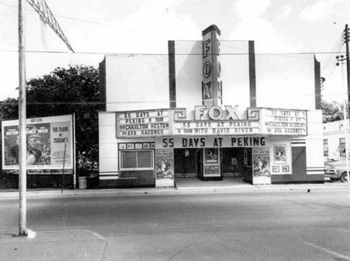
Before I wandered into Atlanta in the early ’70s, I spent eight years in Houma, Louisiana. (Actually it was only about six months; it just seemed like forever.) There were three theaters in Houma and another in Thibadoux. Things got dark for a while in that period of my life, and I developed a pattern of catching an afternoon movie at Nicholls State student union every afternoon and then going to another movie that evening.
When I moved to Atlanta in the early 1970, I got to go to, and be a part of saving the Fabulous Fox, a 5,000 seat, Arabic-theme atmospheric theater built in the late 1920s. Sadly, I saw that city toss away the beautiful Roxy and the historic Lowe’s Grand where Gone with the Wind debuted in 1939.
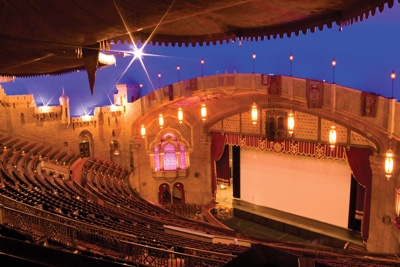
For fifteen years I kept a record of all the movies I paid to see. My best day was three, but I don’t recall what they were. I went to a 24-hour Marx Brothers marathon, and when the Silver Screen opened in the mid ’70s, I found my nirvana. It was a retro movie house showing classic films on a double bill that changed three times a week and more often than not, I made all three bills. Eventually the Silver Screen was done in by the VCR.
I don’t go to the picture show much any more. It’s too expensive; the films are aimed at male adolescents age 15 to 45, and the experience is just not as much fun as it used to be.
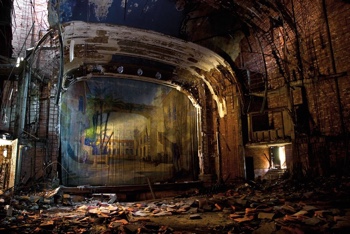
In the ’80s I spent some time traveling through the Northeast, Midwest, and South where I took hundreds of pictures of old theaters, some grand, some plain, many abandoned and dark, in towns large and small. It was sad to see these buildings that had brought so much laughter and excitement to so many, standing empty and forgotten. They deserved better. They deserved to have the shadows dance again across their dark screens.